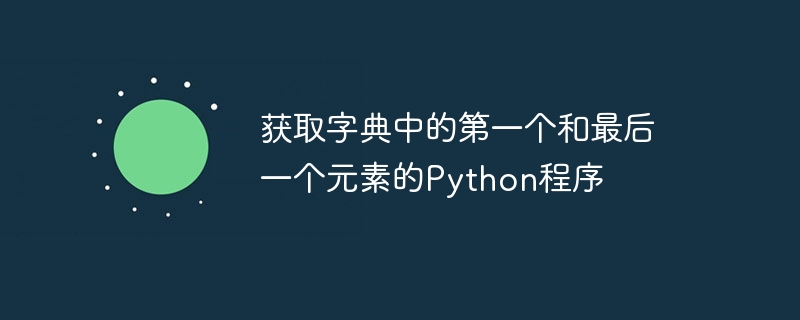取得字典中的第一個和最後一個元素的Python程序

Python是一種解釋型的、物件導向的、進階的程式語言,具有動態語意。由Gudio Van Rossum於1991年開發。它支援多種程式設計範式,包括結構化、物件導向和函數式程式設計。在深入討論這個主題之前,讓我們先複習一下與我們提供的問題相關的基本概念。
字典是一組獨特、可變且有序的項。在字典的書寫中使用花括號,它們包含鍵和值:鍵名可以用來引用字典物件。資料值以鍵:值對的形式保存在字典中。
有序和無序意義
當我們說字典是有順序的時,我們是指其內容有一定的順序,不會改變。無序的項目缺乏明確的順序,因此無法使用索引來找到特定的項目。
範例
請參閱以下範例以更好地理解上面討論的概念。
請注意,字典鍵是區分大小寫的;具有相同名稱但大小寫不同的鍵將被處理成不同的情況。
Dict_2 = {1: 'Ordered', 2: 'And', 3: 'Unordered'}
print (Dict_2)
輸出
{1: 'Ordered', 2: 'And', 3: 'Unordered'}
範例
查看以下範例以更好地理解該概念
Primary_Dict = {1: 'Grapes', 2: 'are', 3: 'sour'}
print("\nDictionary with the use of Integer Keys is as following: ")
print(Primary_Dict)
# Creating a Dictionary
# with Mixed keys
Primary_Dict = {'Fruit': 'Grape', 1: [10, 22, 13, 64]}
print("\nDicionary with the use of Mixed Keys is as following: ")
print(Primary_Dict)
輸出
Dictionary with the use of Integer Keys is as following:
{1: 'Grapes', 2: 'are', 3: 'sour'}
Dictionary with the use of Mixed Keys:
{'Fruit': 'Grape', 1: [10, 22, 13, 64]}
在使用Python時,有許多情況下我們需要取得字典的主鍵。它可以用於許多不同的特定用途,例如測試索引或其他類似的用途。讓我們來介紹一些完成這項工作的方法。
使用list()類別 keys()
可以使用上述技術的組合來執行此特定任務。在這裡,我們只是根據keys()從完整字典中收集的鍵來建立一個列表,然後只訪問第一個條目。在使用它之前您只需要考慮一個因素,即它的複雜性。透過迭代字典中的每個項目,它首先將整個字典轉換為列表,然後提取其第一個成員。這種方法的複雜度是O.(n)。
使用list()類別來取得字典中的最終鍵,如last key = list(my dict)[-1]。字典透過列表類別轉換為鍵列表,透過存取索引-1處的元素可以獲得最後一個鍵。
範例
請參閱以下範例以更好地理解
primary_dict = {
'Name': 'Akash',
'Rollnum': '3',
'Subj': 'Bio'
}
last_key = list(primary_dict) [-1]
print (" last_key:" + str(last_key))
print(primary_dict[last_key])
first_key = list(primary_dict)[0]
print ("first_key :" + str(first_key))
輸出
last_key: Subj Bio first_key :Name
範例
以下程式建立了一個名為Primary_dict的字典,其中包含五對鍵值對。然後將整個字典印到螢幕上,接著分別列印出字典的第一個和最後一個鍵。
primary_dict = {'Grapes' : 1, 'are' : 2, 'sour' : 3, 'and' : 4, 'sweet' : 5}
print ("The primary dictionary is : " + str(primary_dict))
res1 = list (primary_dict.keys())[0]
res2 = list (primary_dict.keys())[4]
print ("The first key of the dictionary is : " + str(res1))
print ("the last key of the dictionary is :" + str(res2))輸出
The primary dictionary is : {'Grapes': 1, 'are': 2, 'sour': 3, 'and': 4, 'sweet': 5}
The first key of the dictionary is : Grapes
the last key of the dictionary is : sweet
範例
如果您只需要字典的第一個鍵,而取得它的有效方法是使用「next()」和「iter()」函數的組合。 iter() 函數用於將字典條目轉換為可迭代對象,而 next() 則取得第一個鍵。此方法的複雜度為 O(1)。請參閱以下範例以更好地理解。
primary_dict = {'Grapes' : 1, 'are' : 2, 'sour' : 3, 'and' : 4, 'sweet' : 5}
print ("The primary dictionary is : " + str(primary_dict))
res1 = next(iter(primary_dict))
print ("The first key of dictionary is as following : " + str(res1))
輸出
The primary dictionary is : {'Grapes': 1, 'are': 2, 'sour': 3, 'and': 4, 'sweet': 5}
The first key of dictionary is as following : Grapes
結論
在本文中,我們解釋了從字典中尋找第一個和最後一個元素的兩個不同範例。我們也編寫了一個程式碼,透過使用 next() iter() 來只尋找字典的第一個元素。
以上是取得字典中的第一個和最後一個元素的Python程序的詳細內容。更多資訊請關注PHP中文網其他相關文章!

熱AI工具

Undresser.AI Undress
人工智慧驅動的應用程序,用於創建逼真的裸體照片

AI Clothes Remover
用於從照片中去除衣服的線上人工智慧工具。

Undress AI Tool
免費脫衣圖片

Clothoff.io
AI脫衣器

AI Hentai Generator
免費產生 AI 無盡。

熱門文章

熱工具

記事本++7.3.1
好用且免費的程式碼編輯器

SublimeText3漢化版
中文版,非常好用

禪工作室 13.0.1
強大的PHP整合開發環境

Dreamweaver CS6
視覺化網頁開發工具

SublimeText3 Mac版
神級程式碼編輯軟體(SublimeText3)

熱門話題
 空字典鍵不正確:如何解決Python的字典鍵錯誤?
Jun 24, 2023 pm 03:03 PM
空字典鍵不正確:如何解決Python的字典鍵錯誤?
Jun 24, 2023 pm 03:03 PM
Python中的字典是一種靈活且強大的資料結構,它可以儲存鍵值對,並且具備快速的查找和插入功能。然而,如果不小心處理字典的鍵值對,可能會遇到空字典鍵的問題。這個問題通常會導致程式碼崩潰或輸出非預期結果。本文將介紹兩種解決Python空字典鍵錯誤的方法。方法一:使用if語句防止空字典鍵Python的字典中不能有重複鍵,否則會覆寫先前的鍵值對。當一個字典鍵的值為空
 取得字典中的第一個和最後一個元素的Python程序
Sep 07, 2023 pm 05:01 PM
取得字典中的第一個和最後一個元素的Python程序
Sep 07, 2023 pm 05:01 PM
Python是一種解釋型的、物件導向的、高階的程式語言,具有動態語意。由GudioVanRossum於1991年開發。它支援多種程式設計範式,包括結構化、物件導向和函數式程式設計。在深入討論這個主題之前,讓我們先複習一下與我們提供的問題相關的基本概念。字典是一組獨特、可變且有序的項。在字典的書寫中使用花括號,它們包含鍵和值:鍵名可以用來引用字典物件。資料值以鍵:值對的形式保存在字典中。有序和無序意義當我們說字典是有序的時,我們是指其內容具有一定的順序,不會改變。無序的項目缺乏明確的順序,因此無法使用
 如何在Python中取得字典中的下一個按鍵?
Aug 28, 2023 pm 11:45 PM
如何在Python中取得字典中的下一個按鍵?
Aug 28, 2023 pm 11:45 PM
字典是Python強大的資料類型。它由鍵值對組成。透過這種資料類型可以有效地完成搜尋、追加等操作。雖然存取字典中的值很簡單,但在某些情況下您可能需要在字典中尋找下一個鍵。 Python提供了多種方法來實現此目的,具體取決於您的特定要求。在本文中,我們將探索在Python中獲取字典中下一個鍵的不同方法。使用keys和index方法字典在Python中是無序集合。因此,我們首先需要將鍵轉換為某種有序形式。我們可以先將所有按鍵以列表的形式追加。接下來,我們可以透過索引列表來找到下一個鍵。借助鍵,我們還可以
 C++程式初始化字典
Sep 09, 2023 pm 07:01 PM
C++程式初始化字典
Sep 09, 2023 pm 07:01 PM
C++在同名的字典方面與Python不同,但它具有相似功能的相同資料結構。 C++支援映射,可在STL類別std::map中使用。映射物件在每個條目中包含一對值,一個是鍵值,另一個是映射值。鍵值用於在映射中搜尋和唯一標識條目。而映射值不一定是唯一的,鍵值在映射中必須永遠是唯一的。讓我們看一下如何使用映射。首先,讓我們看看如何在C++中定義一個映射資料結構。語法#includemap<data_type1,data_type2>myMap;讓我們舉個例子,看看如何做到這一點−範例#incl
 Python程式以刪除字典中的空值為例
Sep 03, 2023 pm 04:45 PM
Python程式以刪除字典中的空值為例
Sep 03, 2023 pm 04:45 PM
字典被稱為集合資料型態。它們以鍵值對的形式儲存資料。它們是有序的且可變的,即它們遵循特定的順序並被索引。我們可以更改鍵的值,因此它是可操縱的或可更改的。字典不支援資料重複。每個鍵可以有多個與其關聯的值,但單一值不能有多個鍵。我們可以使用字典來執行許多操作。整個機制取決於儲存的值。在本文中,我們將討論可用於從字典中刪除「空值」的技術。在開始主要操作之前,我們必須對字典中的值處理有一個深入的了解。讓我們快速瀏覽一下本文的概述。本文分為兩部分-第1st部分將重點放在「空值」的概念及其意義。在第2nd部
 Python中的字典與JSON之間的相互轉換方法有哪些?
Oct 18, 2023 am 10:30 AM
Python中的字典與JSON之間的相互轉換方法有哪些?
Oct 18, 2023 am 10:30 AM
Python中的字典與JSON之間的相互轉換方法有哪些?作為一種十分常用的資料結構,字典在Python中被廣泛應用。而JSON(JavaScriptObjectNotation)作為一種輕量級的資料交換格式,也被廣泛應用於網路資料傳輸和儲存。在Python中,字典與JSON之間的相互轉換是一項常見的操作。本文將介紹幾種常用的方法,並附上相應的程式碼範例。方
 Python程式用於檢查所有字串元素的字元是否按字典順序排列
Aug 30, 2023 pm 08:29 PM
Python程式用於檢查所有字串元素的字元是否按字典順序排列
Aug 30, 2023 pm 08:29 PM
詞彙順序是指基於字典或字母順序的字元或字串的順序。依照詞彙順序,字符的排列方式與字典中的排列方式相同。比較是根據各自字元集(例如ASCII或Unicode)中字元的數值來完成的。按照詞彙順序,字元根據其ASCII或Unicode值從左到右進行比較。具有較低ASCII或Unicode值的字元位於具有較高值的字元之前。例如,依照ASCII順序,「a」位於「b」之前,「b」位於「c」之前,依此類推。比較字串時,詞法順序是透過從左到右比較字串對應的字元來確定的。如果一個字串的第一個字元大於另
 Go語言中的堆疊、堆疊、字典、紅黑樹等資料結構
Jun 03, 2023 pm 03:10 PM
Go語言中的堆疊、堆疊、字典、紅黑樹等資料結構
Jun 03, 2023 pm 03:10 PM
隨著電腦科學的發展,資料結構成為了一門重要的學科。在軟體開發中,資料結構是非常重要的,它們可以提高程式效率和可讀性,同時也可以幫助解決各種問題。在Go語言中,堆疊、堆疊、字典、紅黑樹等資料結構也是非常重要的。本文將介紹這些資料結構及其在Go語言中的實作。堆堆(Heap)是一個經典的資料結構,用來解決優先隊列問題。優先隊列指的是一種隊列,在取出元素的時候,按照元






